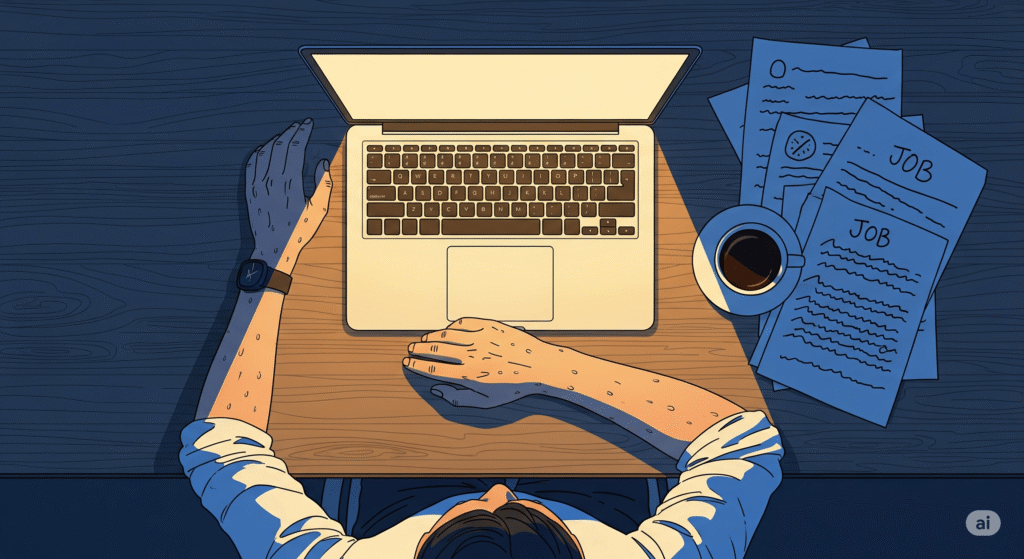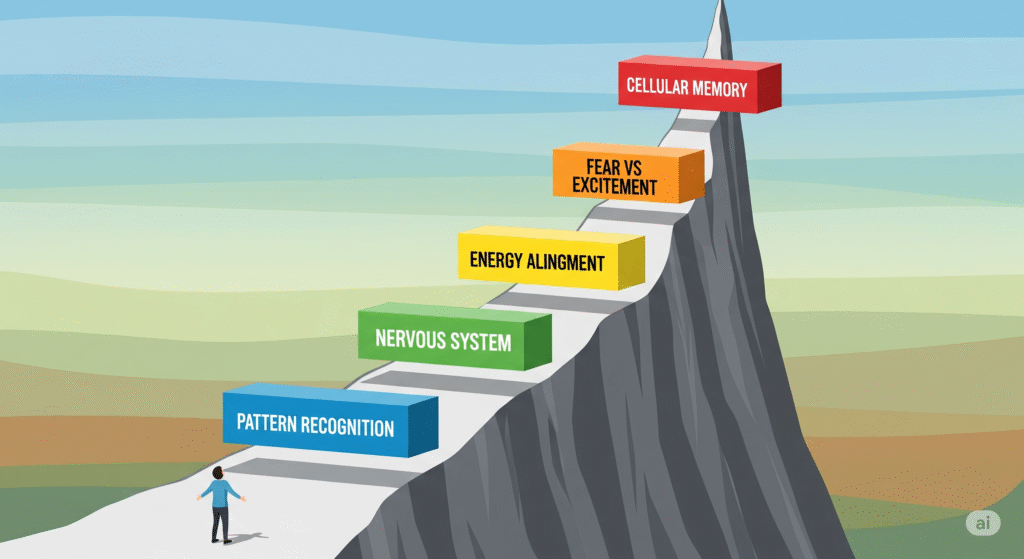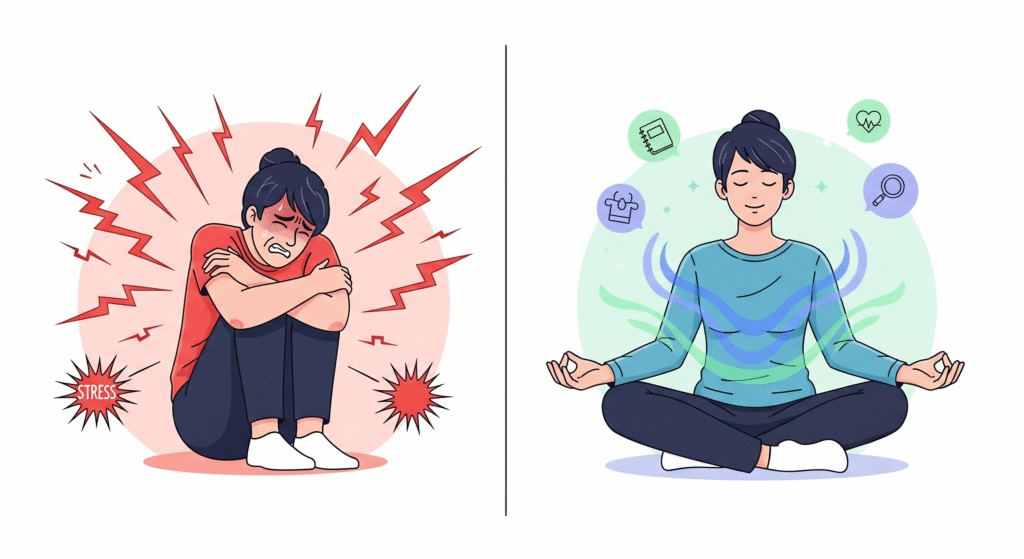Your body knows before your mind does. Those goosebumps aren’t random—they’re your internal GPS.
Picture this: You’re sitting across from a potential employer, discussing a job that could completely reshape your career trajectory. Suddenly, tiny bumps rise along your arms like a wave of electricity. Your heart quickens, not from nervousness, but from something deeper—a recognition that this moment matters.
Or maybe you’re standing at the airport, boarding pass in hand for a move across the country. As you approach the gate, that familiar tingle spreads across your skin. It’s not anxiety exactly, but your body’s way of saying, “Pay attention. Something significant is about to shift.”
Most people dismiss these physical responses as mere coincidence or nerves. But what if I told you that experiencing goosebumps before life-changing moments isn’t just common—it’s your body’s sophisticated early warning system for transformation?
These seemingly mysterious chills that appear before major decisions, relationship changes, or career pivots aren’t accidents. They’re the result of your nervous system, subconscious mind, and even cellular memory working in concert to signal that you’re approaching a threshold moment. Your body often recognizes the magnitude of a situation before your conscious mind catches up.
The phenomenon of getting goosebumps before life changes has fascinated researchers, psychologists, and neuroscientists for decades. From the vagus nerve’s role in intuitive decision-making to the way our subconscious processes patterns we can’t consciously detect, there’s real science behind these mystical-seeming moments.
In this deep dive, we’ll explore why your body produces these physical signals before transformative experiences, what different types of chills mean, and most importantly, how to read and trust these responses as guidance for your biggest life decisions. By the end, you’ll never ignore those meaningful shivers again.
The Goosebumps That Saved My Career

Three years ago, I was miserable in my corporate job but too afraid to leave. The salary was good, the benefits solid, and everyone kept telling me how “lucky” I was to have such stability. But every morning felt like walking into a prison cell.
Then I got a call about a freelance opportunity. Nothing fancy—just a small project with a startup I’d never heard of. As the founder described their mission over the phone, something extraordinary happened. Goosebumps erupted across my arms like I’d just heard my favorite song for the first time. The hair on the back of my neck stood up, and this warm, electric feeling spread through my chest.
I almost dismissed it. After all, it was just a tiny project, a fraction of my corporate salary, with zero job security. But those chills… they felt significant. Like my body was trying to tell me something my logical mind couldn’t grasp yet.
Against all conventional wisdom, I took the project. Then another. Within six months, that “risky” decision had evolved into a thriving freelance career that brought me more fulfillment than a decade in corporate ever had. That startup? They’re now one of my biggest clients, and we’ve built something incredible together.
Looking back, I realize my body knew something my anxious mind couldn’t see. Those goosebumps weren’t random—they were recognition. My nervous system had detected an opportunity that aligned perfectly with my values and potential, even though my logical brain was focused on all the reasons it seemed impractical.
That experience taught me to pay attention when my body sends these signals. Now, whenever I feel that telltale tingle before a big decision, I lean in instead of dismissing it. Those goosebumps have guided me toward some of the best choices I’ve ever made.
What Science Says About Pre-Change Physical Responses
The phenomenon of getting physical responses before significant life events isn’t just anecdotal—it’s backed by fascinating research into how our bodies process information that our conscious minds haven’t fully grasped yet.
Dr. Matthew Sachs, a neuroscientist formerly at Harvard and USC, has extensively studied what researchers call “frisson”—those spine-tingling chills we experience during emotionally significant moments. His research published in the journal <a href=”https://academic.oup.com/scan/article/11/6/884/2223400”>Social Cognitive and Affective Neuroscience</a> shows that people who experience frisson have unique neural connectivity patterns that allow them to process emotional and sensory information more intensely.
But it goes deeper than emotional response. The <a href=”https://www.frontiersin.org/journals/psychology/articles/10.3389/fpsyg.2020.01659/full”>vagus nerve</a>, often called the “wisdom nerve,” plays a crucial role in what we experience as intuitive knowing. This major neural pathway connects your brain to your heart, lungs, and digestive system, creating a communication highway between your conscious mind and your body’s deeper wisdom.
Research published in <a href=”https://pubmed.ncbi.nlm.nih.gov/15505970/”>neuroscience journals</a> demonstrates that our bodies often detect patterns and changes in our environment before our conscious awareness kicks in. The vagus nerve, as shown in studies on decision-making, can improve our ability to make advantageous choices when stimulated, suggesting it plays a crucial role in intuitive decision-making.
Dr. Antonio Damasio’s groundbreaking work on somatic markers shows that our bodies create physical “tags” for experiences, helping us navigate future decisions. When we encounter situations similar to previous life-changing moments, our nervous system activates these stored responses—including those characteristic chills and tingles.
Perhaps most fascinating is research on what scientists call “cardiac coherence”—the alignment between heart rhythm patterns and emotional states. Studies suggest that when we’re about to make decisions aligned with our authentic selves, our heart rate variability patterns actually shift into greater coherence, often accompanied by physical sensations like goosebumps.
This explains why those pre-change chills feel different from regular nervousness or excitement. They’re your entire nervous system recognizing that you’re approaching a moment of authentic alignment—a decision or opportunity that resonates with your deepest values and potential for growth.
5 Reasons Your Body Gives You Goosebumps Before Change

Understanding why your body produces these signals can help you interpret them more accurately. Here are the five primary mechanisms behind those meaningful chills:
Subconscious Pattern Recognition
Your unconscious mind processes thousands of data points every second—facial expressions, vocal tones, environmental cues, energy patterns—that your conscious awareness can’t track. When you get goosebumps before life changes, it’s often because your subconscious has recognized a pattern that signals significant opportunity or alignment.
This pattern recognition explains why you might feel chills during a conversation with someone who becomes a life-changing mentor, or when walking into a space that will become important to your future. Your body is responding to subtle cues that indicate this moment matters, even before you consciously understand why.
Think of it like your internal radar detecting something your logical mind hasn’t catalogued yet. Those goosebumps are your subconscious saying, “Pay attention—this connects to something important.”
Nervous System Excitement Response
When your body senses you’re approaching a threshold moment, your sympathetic nervous system activates—but not always in the fight-or-flight way we typically associate with stress. Sometimes, it’s what researchers call “eustress”—positive arousal that prepares you for growth and expansion.
This physiological excitement creates the perfect conditions for goosebumps. Your body is literally preparing you for transformation, increasing circulation, heightening awareness, and creating that electric feeling that makes you more receptive to possibility.
The key difference between anxiety chills and opportunity chills? Anxiety goosebumps usually come with tension and contraction, while growth-oriented chills feel expansive and energizing, even if they’re accompanied by nervousness.
Energy Alignment Detection
While this might sound mystical, there’s growing research into how we unconsciously detect whether situations align with our authentic selves. When you encounter opportunities, people, or decisions that resonate with your core values and natural strengths, your nervous system responds with recognition signals.
Those pre-change goosebumps often indicate that your body has detected this alignment before your mind has processed it. It’s like your internal compass pointing toward magnetic north—there’s a physical response to finding your true direction.
This explains why you might get chills when meeting someone who becomes a significant relationship, or when considering a career change that finally feels “right.” Your body recognizes the energetic match before your brain can articulate why.
Fear-Excitement Confusion
Sometimes, your nervous system can’t distinguish between fear and excitement because they create nearly identical physiological responses. Both involve increased heart rate, heightened awareness, and skin sensitivity that can trigger goosebumps.
The difference lies in the quality of the sensation and what follows. Fear-based chills usually come with a sense of contraction and wanting to retreat. Excitement-based chills feel expansive and create curiosity about moving forward, even if there’s nervousness involved.
Learning to distinguish between these two types of responses is crucial for reading your body’s signals accurately. True life-change goosebumps feel scary and thrilling simultaneously—they’re your body’s way of saying, “This is big, and it’s worth it.”
Cellular Memory Activation
Your body stores memories of significant experiences at a cellular level, creating what researchers call somatic memories. When you encounter situations that echo previous life-changing moments—whether positive or challenging—your cells can respond with physical sensations, including goosebumps.
This cellular recognition explains why certain places, people, or opportunities can trigger immediate physical responses. Your body remembers what transformation feels like and alerts you when similar conditions are present.
These responses aren’t always about repeating past experiences—sometimes they’re about recognizing opportunities for healing or growth that your cells remember needing.
How to Read and Trust Your Pre-Change Signals

Now that you understand why these responses occur, let’s explore how to interpret and trust them effectively:
The Goosebump Journal Method
Start tracking your physical responses to different situations and decisions. Keep a small notebook or phone app where you record:
- When and where the goosebumps occurred
- What was happening or being discussed
- The quality of the sensation (expansive, contractive, warm, electric)
- What you were thinking or feeling at the time
- What happened afterward
Over time, you’ll notice patterns that help you distinguish between different types of chills and learn to trust your body’s guidance system more confidently.
Body Scanning for Decision Making
When facing important decisions, practice this simple technique:
- Sit quietly and consider option A
- Notice any physical sensations—tension, expansion, energy shifts
- Take a few breaths and clear your mind
- Consider option B and again notice physical responses
- Compare the quality of sensations for each option
Your body often knows which choice serves your highest good before your mind can rationalize it. Trust the option that creates expansion, curiosity, or positive energy, even if it seems scarier logically.
Distinguishing Fear vs. Excitement Chills
Learn to differentiate between different types of goosebumps:
- Fear chills: Usually accompanied by tension, shallow breathing, desire to retreat
- Excitement chills: Feel expansive, create curiosity, accompanied by deeper breathing
- Recognition chills: Warm, knowing feeling, often with emotional response
- Warning chills: Sharp, uncomfortable, create urgency to avoid or be cautious
The more you practice noticing these distinctions, the more accurately you can read your body’s messages.
Using Physical Responses as Guidance
Start small by using goosebump responses for lower-stakes decisions—which book to read, which route to take home, which friend to call. As you build confidence in reading these signals, you can apply this guidance to bigger life choices.
Remember, your body’s wisdom doesn’t replace logical thinking—it complements it. The most powerful decisions often come from aligning both your rational analysis and your intuitive knowing.
Types of Life-Change Goosebumps
Understanding different categories of life-change chills can help you interpret your experiences more accurately:
| Situation | What Your Body Knows |
|---|---|
| Job interviews | Alignment with values and potential |
| New relationships | Energetic compatibility and growth potential |
| Creative projects | Authentic expression opportunities |
| Travel decisions | Growth and expansion possibilities |
| Living spaces | Environmental harmony and support |
| Learning opportunities | Resonance with natural gifts |
| Health decisions | Body’s wisdom about healing |
| Financial choices | Alignment with security and values |
Each type carries different information. Career-related goosebumps often signal value alignment, while relationship chills might indicate energetic compatibility or growth potential. Creative project tingles usually mean you’re touching something authentic and meaningful to express.
The key is paying attention to the context and quality of the sensation. Sharp, uncomfortable chills might be warnings, while warm, expansive feelings typically signal positive alignment.
Learning to read these different “flavors” of goosebumps turns them into a sophisticated guidance system for navigating life’s biggest decisions with greater wisdom and confidence.
Your Body’s Wisdom is Worth Trusting
Those goosebumps that appear before life-changing moments aren’t mystical accidents—they’re your body’s sophisticated early warning system for transformation. Your nervous system, with its millions of years of evolutionary wisdom, often recognizes significance before your conscious mind catches up.
Think back to that image from the beginning—you sitting across from a potential employer, feeling those electric tingles spread across your skin. Now you know those sensations weren’t random. They were your internal GPS detecting that this moment mattered, that this opportunity aligned with something deeper than just logical career advancement.
Your body is constantly gathering information from sources your conscious mind can’t access—energy patterns, micro-expressions, environmental cues, cellular memories, and subconscious pattern recognition. When it detects that you’re approaching a threshold moment, it signals you through physical sensations like goosebumps, that warm electric feeling, or the sense that your heart is expanding.
The most successful people I know aren’t just logical decision-makers—they’re skilled at reading their body’s wisdom and factoring it into important choices. They’ve learned that sometimes the “illogical” decision that gives them chills is exactly the leap their soul needs to make.
This doesn’t mean abandoning rational thinking or making reckless choices based solely on physical sensations. It means honoring the full spectrum of intelligence available to you—logical analysis and intuitive knowing working together to guide you toward your most authentic path.
Your goosebumps are not coincidences. They’re invitations to pay closer attention, to consider that maybe, just maybe, your body knows something your worried mind hasn’t figured out yet. Trust those tingles. Follow those chills. Let your body’s wisdom be part of your guidance system for navigating life’s most important moments.
When did goosebumps guide you to something amazing? Share your story! ✨
RECOMMENDED CATEGORY: Psychology & Self-Development
Sub-categories could include:
Decision Making & Intuitionation?
Personal Development
Psychology & Behavior
Self-Awareness & Growth
Mind-Body Connection
These seemingly mysterious chills that appear before major decisions, relationship changes, or career pivots aren’t accidents. They’re the result of your nervous system, subconscious mind, and even cellular memory working in concert to signal that you’re approaching a threshold moment. Your body often recognizes the magnitude of a situation before your conscious mind catches up.
The phenomenon of getting goosebumps before life changes has fascinated researchers, psychologists, and neuroscientists for decades. From the vagus nerve’s role in intuitive decision-making to the way our subconscious processes patterns we can’t consciously detect, there’s real science behind these mystical-seeming moments.
In this deep dive, we’ll explore why your body produces these physical signals before transformative experiences, what different types of chills mean, and most importantly, how to read and trust these responses as guidance for your biggest life decisions. By the end, you’ll never ignore those meaningful shivers again.
When did Goosebumps guide you to something amazing? Share your story! ✨

